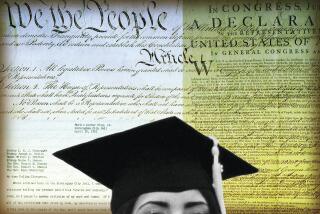Warning: College students, this editorial may upset you
The latest attack on academic freedom comes not from government authorities or corporate pressure but from students. At UC Santa Barbara, the student Senate recently passed a resolution that calls for mandatory “trigger warnings” — cautions from professors, to be added to their course syllabi, specifying which days’ lectures will include readings or films or discussions that might trigger feelings of emotional or physical distress.
The resolution calls for warnings if course materials will involve depictions and discussions of rape, sexual assault, suicide, pornography or graphic violence, among other things. The professors would excuse students from those classes, with no points deducted, if the students felt the material would distress them; it is left unclear how students would complete assignments or answer test questions based on the work covered in those classes.
The student resolution is only advisory, a recommendation that campus authorities can turn into policy or reject. They should not only choose the latter course but should explain firmly to students why such a policy would be antithetical to all that college is supposed to provide: a rich and diverse body of study that often requires students to confront difficult or uncomfortable material, and encourages them to discuss such topics openly. Trigger warnings are part of a campus culture that is increasingly overprotective and hypersensitive in its efforts to ensure that no student is ever offended or made to feel uncomfortable.
Trigger warnings have been used on the Internet for a long time, first appearing on feminist websites visited by victims of sexual attacks; the goal was to protect assault victims from material that might trigger post-traumatic stress disorder. The warnings spread to a wide variety of websites and material that readers might find troubling.
That’s fine for websites that voluntarily choose to caution their visitors, but it’s exactly the wrong approach for colleges and universities. Oberlin College in Ohio already has gone further than UC Santa Barbara, issuing official trigger-warning guidelines for professors that sound almost like a parody of political correctness: “Triggers are not only relevant to sexual misconduct but also to anything that might cause trauma. Be aware of racism, classism, sexism, heterosexism, cissexism, ableism and other issues of privilege and oppression. Realize that all forms of violence are traumatic.”
Worse, the Oberlin guidelines go on to advise professors to remove “triggering material” from their courses entirely if it is not directly related to the course’s learning goals. Such instructions come dangerously close to censorship.
Chinua Achebe’s novel “Things Fall Apart” is listed by Oberlin as one possible “trigger” book because of its themes of colonialism, racism, religious prejudice and more. At Rutgers, an op-ed in the student paper suggested that study of “The Great Gatsby” should require trigger warnings about violence and gore. And then what happens? Should students be excused from reading a work of great literature, or be allowed to read a sanitized version?
Professors, uncertain of what might be considered too sexual, too warlike or so forth, might issue warnings so broad that they’re meaningless, or feel pressured to bleach the syllabus to a pallid version of a real college course.
There are students who suffer from post-traumatic stress disorder, a serious psychological condition that calls for sensitive treatment. Students who have been diagnosed with it could explain their situation to individual professors, who almost certainly would be willing to work out a sensible accommodation, preferably one that wouldn’t involve missing multiple classes.
But the Santa Barbara resolution doesn’t cover only students who have been diagnosed with PTSD. Any student who is discomfited by the material would be excused from class if this were campus policy.
As psychologists point out, a post-traumatic response is just as likely to be triggered by something that has nothing to do with subject matter: a glimpse of the same blue-colored clothing that was visible during a traumatic event, or a certain scent that was in the air that day. Colleges cannot bubble-wrap students against everything that might be frightening or offensive to them.
More to Read
Sign up for Essential California
The most important California stories and recommendations in your inbox every morning.
You may occasionally receive promotional content from the Los Angeles Times.










